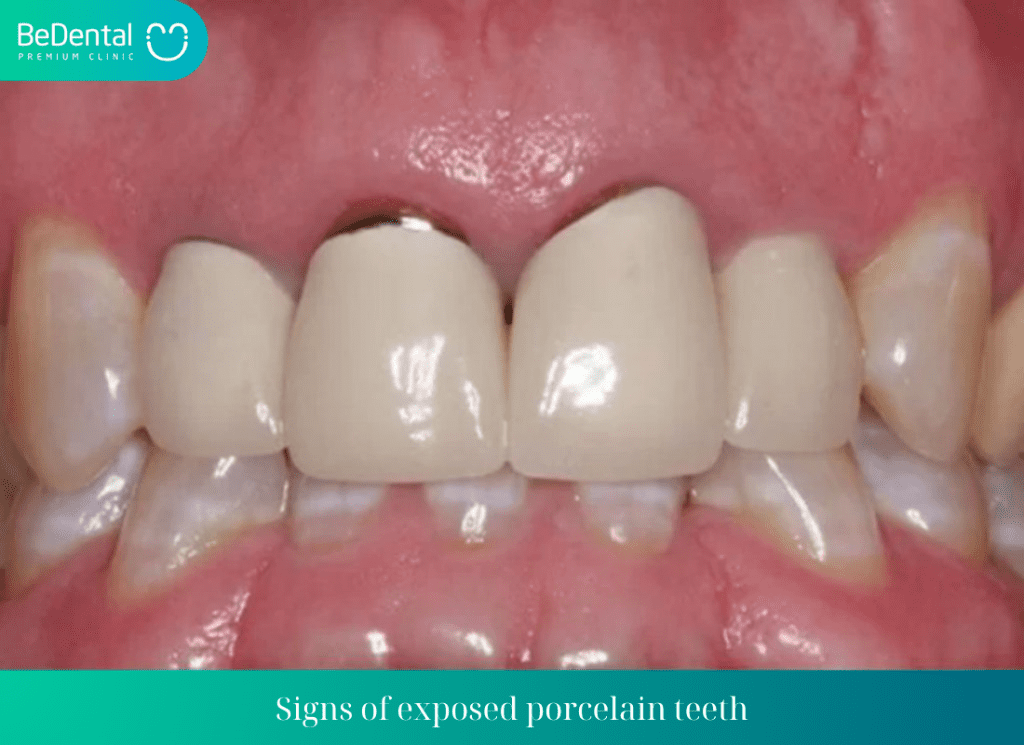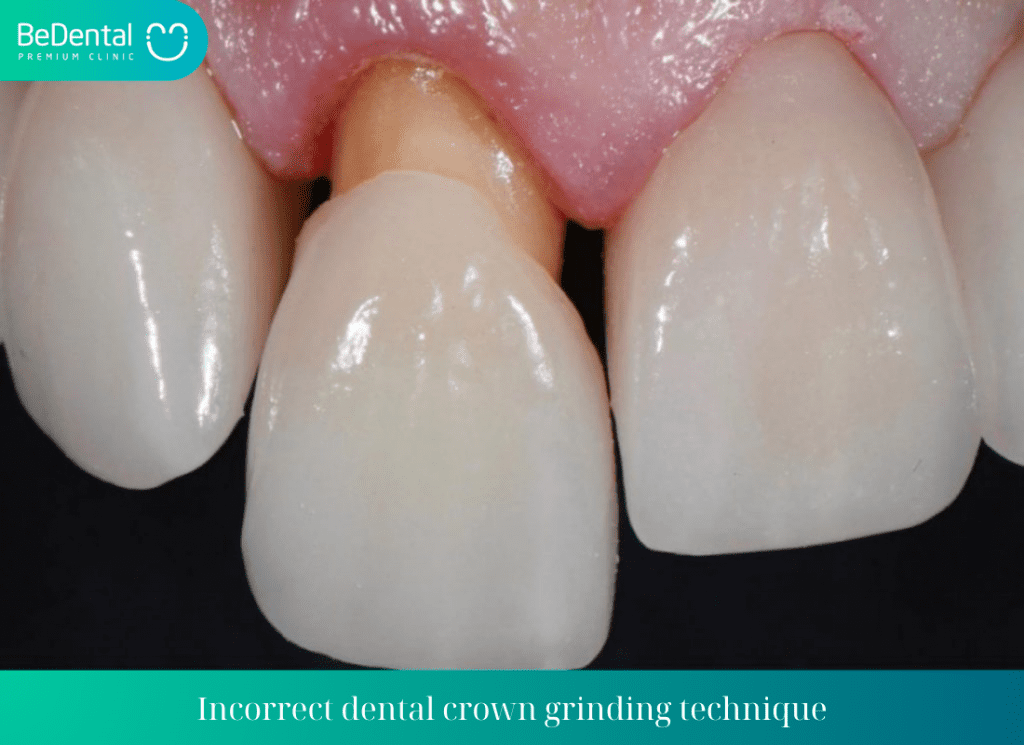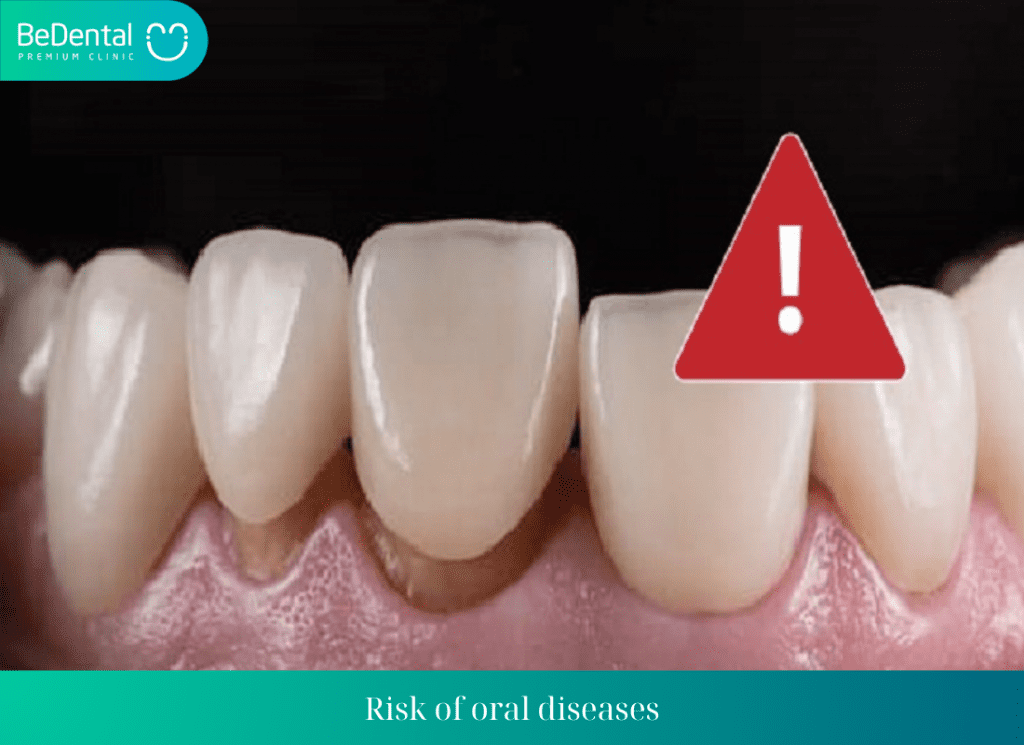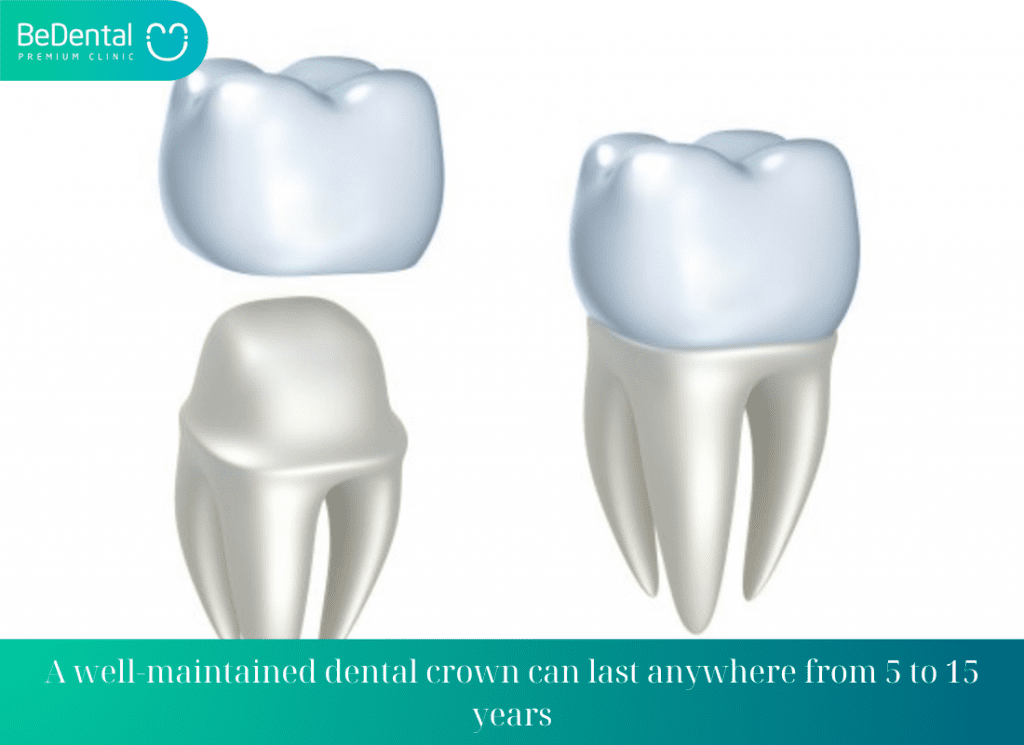Not all customers achieve the expected results after getting dental crowns. Some have experienced the issue of exposed porcelain teeths coming off the tooth, causing aesthetic concerns and potentially dangerous oral health problems. So, what are the Signs of exposed porcelain teeth? What are the causes of this condition, and are there methods to fix it? Let Bedental dental clinic answer these questions in the following article!
Signs of exposed porcelain teeth
The process of getting a dental crown requires meticulous and careful steps to ensure proper, beautiful, and durable restoration.
One common issue is the problem of an exposed porcelain teeth at the base of the tooth. Bedental dental clinic will outline specific signs as follows:
Black fuzzy lines may appear around the gum near the dental crown.
- A gap may be visible between the dental crown and the gum, causing the gum not to snugly fit around the base of the tooth.
- The gum may recede gradually, exposing the root of the tooth.
- Sensitivity or discomfort in the dental crown, especially with hot or cold foods.
- The dental crown may become loose and difficult to chew with.
- Food may get stuck in the gap, leading to bad breath and poor hygiene.
When noticing these signs, customers should promptly visit the dental clinic for examination and timely treatment to prevent the condition from worsening and affecting oral health.

Causes of an exposed porcelain teeth
What are the causes of an exposed porcelain teeth? With many years of experience in cosmetic dental crowns, we will identify the 5 main reasons leading to the condition of a dental crown becoming loose at the base of the tooth as follows:
Incorrect dental crown grinding technique
The most crucial step in the dental crown procedure is grinding the tooth. Grinding the tooth accurately and in the correct proportions will minimize future risks. However, if the dentist lacks experience and skill, it can lead to wrongly assessing the grinding proportions, causing excessive damage to the tooth structure.
When the natural teeth are damaged, they may gradually weaken and cause gum recession, resulting in the dental crown becoming loose at the base of the tooth.
Mismatch between the dental crown and the abutment tooth
To ensure that the dental crown fits perfectly with the abutment tooth, the process of taking impressions and crafting the dental crown must be carried out with absolute precision.
If the impression-taking process is incorrect or if the dental lab designs the dental crown inaccurately, this can lead to the dental crown not fitting properly on the tooth, causing inconsistency and creating a gap.

Poor quality dental crowns
If low-quality dental crowns are used, they may easily wear down, crack, or chip over time. Additionally, they can cause irritation to the gums and abutment tooth area, leading to swelling and inflammation. When this condition continues, the dental crown may be pushed up and create a gap at the base of the tooth.
See more: Can a broken denture be repaired?
Inadequate dental crown adhesive
Using low-quality adhesive can prevent the dental crown from securely adhering, leading to the risk of the dental crown becoming loose. During eating or oral hygiene practices, applying strong pressure can create gaps, even causing the dental crown material to detach from the tooth.
Improper oral hygiene
Using a toothbrush that is too hard can damage the dental crown material and lead to the dental crown becoming loose. Additionally, brushing too forcefully in a horizontal direction or using dental floss too frequently can cause the dental crown material to shift or create gaps.
Consequences of a loose dental crown
What are the consequences of a loose dental crown? If not addressed promptly upon detecting signs of a loose dental crown at the base of the tooth, it can lead to serious consequences such as:
- Risk of oral diseases: Gaps between the dental crown and the abutment tooth provide an environment for food debris to accumulate, creating an ideal breeding ground for bacteria. This can lead to issues such as bad breath, cavities, pulpitis, gingivitis, and periodontitis.
- Risk of natural tooth loss: If not treated promptly and effectively, oral diseases can weaken and damage the inner abutment tooth, increasing the risk of natural tooth loss.
- Increased tooth sensitivity: A loose dental crown can cause pain and sensitivity when exposed to hot, cold, or sweet foods.

- Impact on aesthetics: A loose dental crown can expose the inner abutment tooth, causing gum recession and disrupting the harmony and natural appearance of the smile, affecting aesthetics.
- Impact on digestion: Improperly fitted dental crowns can reduce chewing function, causing discomfort and pain while eating. This can lead to loss of appetite, a decrease in the quality of digestion, and an increased risk of digestive issues.
What to do with a loose dental crown?
What to do with a loose dental crown? To prevent the signs of a loose dental crown mentioned earlier, when a customer notices signs of a loose dental crown, it is crucial to visit the dentist as soon as possible for an examination and solution.
At Bedental dental clinic, we will re-evaluate the size and quality of the dental crown material, as well as remeasure the abutment tooth that has been ground down.
Based on the examination results, the dentist will choose the appropriate corrective measures:
- If size discrepancy is the cause, one option may be to remove the old dental crown and create a new one with a better fit.
- If the issue is due to irritation between the gums and the dental crown, the dentist may suggest using a different material, such as all-ceramic crowns, to minimize irritation.
- In cases where the adhesive and dental crown are still stable, the dentist may remove the dental crown and reattach it with a higher-quality adhesive.
- Additionally, if the loose dental crown persists and causes oral health issues, the dentist will prioritize treating these issues before proceeding with a new dental crown.

In summary, the main cause of dental crown loosening primarily comes from poor dental skills and substandard crown materials. Therefore, it is important for customers to choose a reputable and high-quality cosmetic dental clinic to ensure successful dental restoration results and maintain oral health.
See more: What is tooth filling?
Most asked questions
Can a loose dental crown be fixed, or does it need to be replaced
Whether a loose dental crown can be fixed or needs to be replaced depends on the specific circumstances and the extent of the issue.
In some cases, if the underlying tooth structure is healthy and the crown is minimally loose, it may be possible to re-cement or reattach the existing crown with a high-quality adhesive.
However, if the crown is severely damaged, if there is decay or structural issues with the abutment tooth, or if the fit of the crown is compromised, replacement may be necessary for long-term stability and oral health. It is important to consult with a dentist to assess the situation and determine the most appropriate course of action for addressing a loose dental crown.
Is it normal for a dental crown to feel loose sometimes
While a dental crown is designed to fit securely over a tooth, it is not normal for a dental crown to feel loose at any time. A properly fitted dental crown should feel stable and secure in the mouth.
If you experience a sensation of looseness with your dental crown, it could indicate underlying issues such as improper fit, damage to the crown or abutment tooth, or loosening of the adhesive.
It is important to contact your dentist as soon as possible if you feel that your dental crown is loose, as prompt evaluation and treatment can help prevent further complications and ensure the longevity of the restoration.
How long should a dental crown last before it may become loose?
The lifespan of a dental crown can vary depending on various factors such as the quality of the materials used, oral hygiene practices, regular dental care, and individual habits.

In general, a well-maintained dental crown can last anywhere from 5 to 15 years or more. However, it is not uncommon for a dental crown to become loose before the end of its expected lifespan due to factors such as wear and tear, trauma, decay, or improper fit.
If you notice any signs of a loose dental crown, such as movement or discomfort, it is essential to seek prompt dental evaluation and necessary treatment to address the issue and prevent further complications. Regular dental check-ups can also help in monitoring the condition of dental crowns and ensuring their longevity.
Conclusion
In conclusion, the integrity of dental crowns can be compromised by various factors such as poor quality materials, inadequate adhesive, and improper oral hygiene practices.
A loose dental crown can lead to oral health issues, including increased risk of oral diseases, natural tooth loss, and heightened tooth sensitivity.
Addressing a loose dental crown promptly is crucial to prevent these consequences. It is essential to seek professional dental care for proper diagnosis and treatment. Choosing a reputable and skilled dental practitioner along with high-quality materials is key to ensuring successful dental crown restoration and maintaining overall oral health.
Tư vấn chuyên môn bài viết:
BÁC SĨ DƯƠNG THỊ THÙY NGA





